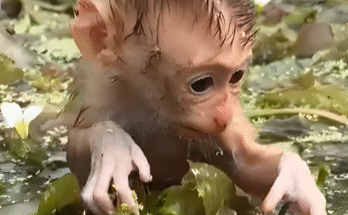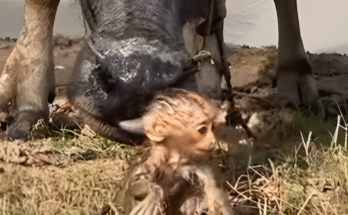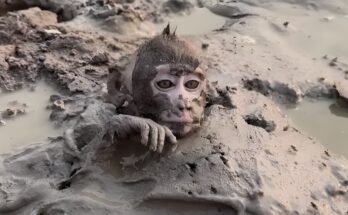A Heartbreaking Moment by the Water
Near the edge of a quiet lake, a tiny baby monkey was spotted struggling to stay above the surface. Its wet fur stuck to its body, and its small hands desperately tried to grip the muddy shoreline.
The little monkey looked exhausted, frightened, and clearly unable to climb out on its own.
How the Baby Monkey Ended Up in the Water
No one knows exactly what happened, but it is common for young monkeys to slip into lakes or ponds when:
- They are playing near the edge
- They lose balance on wet ground
- They become separated from their group
- They panic after falling from a nearby tree
Baby monkeys lack the strength of adults, so even shallow water can quickly become dangerous for them.
The Struggle to Stay Alive
With each small movement, the monkey tried to pull itself out of the mud, but the ground was too slippery.
Its cries and trembling showed fear and desperation — a silent plea for help.
Luckily, scenes like this often attract the attention of nearby villagers, farmers, or wildlife rescuers who understand how fragile these animals are.
Rescuers Step In
When people noticed the baby monkey’s distress, they approached slowly so they wouldn’t scare it further.
Using sticks, ropes, or simply their hands, rescuers carefully lifted the monkey out of the water and onto safe ground.
Once rescued, the monkey usually receives:
- A gentle cleaning
- Drinking water
- Warmth
- Transport to a wildlife care center if needed
These small acts of kindness can make the difference between life and death.
A Reminder of Human Compassion
Seeing a baby animal struggle reminds us that every life — big or small — deserves care.
Helping wildlife doesn’t always require bravery; sometimes it just requires noticing and calling the right people.
What You Should Do If You See an Animal in Trouble
- Stay calm and avoid sudden movements
- Do not jump into dangerous water yourself
- Call local wildlife rescue or animal protection teams
- Use tools (branches, ropes, nets) to help if it’s safe
- Keep the animal warm and calm after the rescue
Sometimes just making a phone call can save a life.



